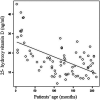Clinical and Laboratory Findings by Serum Vitamin D Levels in Children with COVID-19
- PMID: 36301009
- PMCID: PMC9797750
- DOI: 10.5152/eurasianjmed.2022.22213
Clinical and Laboratory Findings by Serum Vitamin D Levels in Children with COVID-19
Abstract
Objective: The studies on children with COVID-19 are very limited. The aim of this study is to reveal the effect of serum 25-hydroxy vitamin D level on clinical and laboratory parameters.
Materials and methods: The study included 74 children (35 boys and 39 girls) diagnosed with COVID-19. The retrospective data were obtained from the file records of the patients. Seventy-four patients were divided into 3 groups (group 1, deficient; group 2, insufficient; and group 3, sufficient) according to their serum 25-hydroxy vitamin D levels.
Results: The mean age of all patients was 113.25 ± 64.55 months. The mean leucocyte count was substantially higher in group 3 compared to groups 1 and 2 (P = .05 and P = .002, respectively). The mean lymphocyte and platelet count in group 3 was remarkably higher than both groups 1 and 2 (P = .001 and P = .002; and P = .04 and P = .01, respectively). The mean serum parathyroid hormone concentration in group 1 was markedly higher than both groups 2 and 3 (P=.003 and P = .002, respectively) while the mean serum 25-hydroxy vitamin D level in group 1 was remarkably lower than both groups 2 and 3 (P=.001 and P=.001, respectively). Serum 25-hydroxy vitamin D concentrations were positively correlated with leucocyte, lymphocyte, and platelet counts (r=0.221, P=.05; r=0.396, P=.001; and r=0.249, P=.03, respectively) while there was a negative correlation with parathyroid hormone concentrations (r=-0,436, P=.001).
Conclusion: This study suggests that COVID-19 has a benign course in children and that serum 25-hydroxy vitamin D concentration may have a role in the lymphocyte count.
Figures






Similar articles
-
Linear growth in relation to the circulating concentrations of insulin-like growth factor I, parathyroid hormone, and 25-hydroxy vitamin D in children with nutritional rickets before and after treatment: endocrine adaptation to vitamin D deficiency.Metabolism. 2008 Jan;57(1):95-102. doi: 10.1016/j.metabol.2007.08.011. Metabolism. 2008. PMID: 18078865
-
Vitamin D levels in Indian children with intrathoracic tuberculosis.Indian J Med Res. 2014 Oct;140(4):531-7. Indian J Med Res. 2014. PMID: 25488448 Free PMC article.
-
Effect of Vitamin D and parathyroid hormone levels on the coronary slow-flow phenomenon.Niger J Clin Pract. 2019 Sep;22(9):1201-1207. doi: 10.4103/njcp.njcp_177_18. Niger J Clin Pract. 2019. PMID: 31489854
-
Assessment of immune status in relation to vitamin D levels in children on regular hemodialysis.Saudi J Kidney Dis Transpl. 2012 Mar;23(2):267-73. Saudi J Kidney Dis Transpl. 2012. PMID: 22382217
-
Effects of vitamin D supplementation on the calcium-phosphate balance in renal transplant patients.Kidney Int. 2009 Mar;75(6):646-51. doi: 10.1038/ki.2008.549. Epub 2008 Oct 15. Kidney Int. 2009. PMID: 18923386 Clinical Trial.
Cited by
-
Vitamin D Levels in COVID-19 and NonCOVID-19 Pediatric Patients and Its Relationship with Clinical and Laboratory Characteristics.Biomedicines. 2024 Apr 18;12(4):905. doi: 10.3390/biomedicines12040905. Biomedicines. 2024. PMID: 38672258 Free PMC article.
-
SARS-CoV-2 Infection and Candidate Biomarkers.Eurasian J Med. 2022 Dec;54(Suppl1):16-22. doi: 10.5152/eurasianjmed.2022.22305. Eurasian J Med. 2022. PMID: 36655440 Free PMC article.
-
Role of Vitamin D and Vitamin D Polymorphisms in COVID-19 Risk and Severity in Children: A Systematic Review.Cureus. 2024 May 29;16(5):e61326. doi: 10.7759/cureus.61326. eCollection 2024 May. Cureus. 2024. PMID: 38947671 Free PMC article. Review.
-
Association Between the Level of Vitamin D and COVID-19 Infection in Children and Adolescents: A Systematic Review.Am J Trop Med Hyg. 2024 Sep 3;111(5):1127-1132. doi: 10.4269/ajtmh.24-0206. Print 2024 Nov 6. Am J Trop Med Hyg. 2024. PMID: 39226905
-
Is Extracorporeal Membrane Oxygenation a Panacea?Eurasian J Med. 2023 Dec;55(1):S27-S34. doi: 10.5152/eurasianjmed.2023.23269. Eurasian J Med. 2023. PMID: 39128031 Free PMC article.
References
LinkOut - more resources
Full Text Sources
